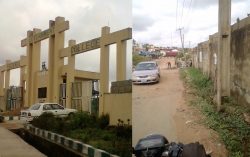Education
Education ministry officials collude with principals to sabotage FG’s Safe School Program
Published
5 years agoon
By
Editor
While Unity Schools principals budget millions yearly for perimeter fencing they are building in the sky, their supervising department remains the pillar behind the imaginary walls.
By Elijah Olusegun
Last November, former Education Minister Adamu Adamu made a dash to flaunt the accountability of his ministry and President Muhammadu Buhari’s administration. He gave a lowdown of the N7bn the ministry spent on beefing up security infrastructure in 104 federal government colleges across the nation in 2017 and 2018.
Reeling out the figures on cameras, he believed, was the honest thing to do as the chief steward of the nation’s education sector.
“As far as I am concerned, the best and only way to be accountable to the Nigerian people is through the media,” he said at a press conference in Abuja. The minister also pointed out that opening up the book would ensure civic participation in the projects.
“Civil society groups and communities where these schools are located [will be able] to monitor the implementation of the projects,” he enthused.
His seeming candour inspired this investigation, which determined his claims were far from the truth.
The federal government colleges, also known as unity schools, and their supervising department, have built around them layers of bureaucratic bulwarks that no journalist or civil society group can penetrate. And inside there, a lot of things go on—things for which many of the school administrators will be hard put to account.
Perimeter fencing is one of them. And it stands out in the on-going rot on two fronts: the federal government’s N7bn school security infrastructure initiative and the FGC annual capital projects.
A case in point: The Federal Government College, Odogbolu, Ogun, budgeted N180.9m in 2017, and N7.9m in 2018, totaling N188.8 million, for constructing a new perimeter fence, as part of its yearly capital projects. It invited tenders on one of those two occasions. But the school authorities would not welcome the media poking around for what they spent on what the reporter discovered on ground. “We don’t talk to the press as civil servants,” one of the school’s vice principals, who said he had just been transferred there, told the National Daily. “You must get a letter from the ministry permitting you to come and interview us.”
That was a necessary excuse. But, really, at the FGC Odogbolu, a school sprawling over a swathe of land the size of three stadiums, there was nothing to say about the perimeter fencing project.
There was no new fence. No need for a new one, to begin with, let alone budgeting N188m for it in two years. The fence around the school perimeter had been there years before 2017. The profile of the walls close to the school gate, and even elsewhere, revealed a mix of decades-old and recent bricks.
Those living around the school told the newspaper that no construction took place around the perimeter fence in 2017 and 2018. It had been there for as long as they could remember.
“What the school has been doing is mend any part of the fence that breaks down,” a resident of Odogbolu explained. With a long, hard look, any observer would note the patches were not difficult to make out. And along the major road on the school premises, close to the gate, there were hundreds of clean cement blocks sitting in piles like six feet high. “It’s from there they take blocks for the fence mending,’’ the resident added. The school used the blocks for any other construction too—not for mending the fence alone.
As a government ministry or department or agency, making a budget for what you don’t need—or spending the fund released on something other than it is proposed for— comes across as a financial sleight of hand. It is a breach of Section 18(14.3.1)(ii-ii) of the Public Procurement Act (PPA 2007) which ensures needs assessment, and identification of goods, works, and services come before financial planning. And, illegal as such procurement manipulation is, it is widespread in this aspect of Nigeria’s education.

The FGC Odogbolu administrators in those two years were not the only ones in the perimeter fencing budget game. There was a gang of principals—or directors, according to the civil service hierarchy—that might have shaved at least N277m off the slack they and the approving departments created from just the FGC fencing budgets.
In the southwest alone, no fewer than 14 principals had been proposing millions in their annual budgets since 2016, for constructing hundreds of metres of perimeter fences their schools already had. And when the federal government released the billions it claimed it did for school security infrastructure, many of the principals—at FGC Ogbomosho, Ikole Ekiti, Ikare-Akoko, Shagamu, amongst others—would only add a layer or two of blocks atop the old fence, especially the sections around the main entrance.
Other principals would just brick up clefts and cracks that age or impact or erosion made in the walls. Some, like the Ikare Akoko FGC, polished the outer parts of the fence and mixed some red ceramic blocks in patches all around.
That is all a prying eye is allowed to see—the glamour of the outside fence putting on a new complexion every year. Other details to prove the value for money spent on the perimeter fencing projects are an official secret, including the series of activities that came before the project—from need assessment to budgetary planning, bidding, contract awards, and projects execution. Even the notice boards that usually mark federal government project sites were not in place. The principals carried on as if they operated in a world where transparency to the media and taxpayers is a dirty word. And that confidence bolstered them up to make free with public funds by budgeting for a need already met.
The FGC supervising office, the Department of Basic and Secondary Education, also seems ready to play along in this. “You are chasing a shadow,” said the department’s media director, Ben Goong, as he declined the National Daily’s FOIA request and interviews for clarification on funds released and other details. Goong would only insist there was no corruption in the process.
The loophole
According to the Organisation for Economic Co-operation and Development (OECD), between 10 percent and 30 percent of government procurement is lost to corruption, In more transparent climes, that is. The rate in such government spending in Africa, especially Nigeria, is better imagined. Looking at the patterns of repetition and cost inflation in those years, it appears that the FGC perimeter fencing was not necessarily about security of the schools. It only presented an opportunity—for leakages. And most civil servants would not bat an eyelid if they had to dig their fingers in the till for handfuls of the budget surplus. The odds were in their favour, after all.
The Federal Ministry of Education, in 2016, just laid a blanket order: that all the 104 FGCs across the nation should strengthen their school security with CCTV cameras, modern gates, solar street light, and perimeter fencing. Making it part of its own capital projects, the education ministry’s between 2017 and 2018, budgeted N7bn for this and tagged it security infrastructure in FGCs.
Principals of at least 12 of the 17 schools in the southwest, however, cashed in on the broad directive. Alongside the multibillion-naira headquarters security infrastructure project for the FGCs, which included perimeter fencing, another perimeter fencing project kept coming up annually. This time, it was part of the FGCs own capital projects. Eight of the principals pushed theirs twice between 2016 and 2018.
The National Daily made effort to clarify whether the headquarters budget—and the perimeter fencing item of the security infrastructure project—are the same as the FGC’s perimeter fencing capital projects. There was no response from the authorities.
The minister’s order, which brought about this duplicity, was a knee-jerk response. It was made after Boko Haram abducted 276 schoolgirls at the Federal Government Girls College, Chibok, Borno, and killed 59 schoolboys at the Federal Government Boys College, Buni Yadi, Yobe in 2014. Securing public schools then became a hot potato in Nigeria and across the world. Many experts and big businesses bristling with Corporate Social Responsibility, CSR, dollars also weighed in on the discussion. An offshoot of that was the Safe School Initiative.
Former British PM Gordon Brown, in partnership with many multinationals, in Nigeria and abroad, came and launched the initiative in Abuja in 2014. A sum of $10m was floated to improve security in 500 public schools in the pilot phase of the initiative.
In spite of that, violence on school premises had risen higher by 2016. UNICEF said over 50 percent of school children were exposed to violence at school. The federal government, then, had to double its efforts. It began voting funds for perimeter fencing, along with other security measures, in public schools, from the primary level to the tertiary level.
According to Adamu, 69 of the FGCs got N5bn for perimeter fencing and other security projects in 2017, while 35 got about N2bn in 2018.
But, in his defense of the principals’ transparency, the Department of Basic and Secondary Education’s spokesperson gave the National Daily a different figure. “Security infrastructure were to be provided in terms of fencing, gates, and solar-powered streetlights, and CCTV cameras across 34 unity colleges,” Goong said in a text message he sent May 20.
No fence. More funds. More fraud
Those two years were not the first time perimeter fencing, among other security projects, would stick up in the budget. Under Adamu, FGCs budgeting for that line item dates back earlier, at least to 2016. Four of the 17 schools in the southwest were allocated funds same year, and in 2017. (Only three of the region’s unity schools—in Akure, Queens College in Lagos, Kings College also in Lagos—never bothered about perimeter fencing between 2016 and 2018.)
Four of those that budgeted for fencing in 2017 also came back in 2018. That made it eight schools budgeting twice between 2016 and 2018—for constructing fences that had been standing there for decades. In the budget, some were tagged “new”, others, “on-going”.

FGC, Ijaniki Perimeter Fence
For the 2016 budget, half of the fencing vote for each of the four schools was released, as part of the 2016 capital releases, according to a document by BudgIT, a public finance watchdog. For instance, the Ijanikin FGC got N7.4m of the N14.7m budgeted for its perimeter fencing in 2016. The FGC Ikirun got N7.5m of the N15m it budgeted; the one in Oyo got N10m of its N25.2m; the unity school at Ijebu Mushin got N8.4m of its N16.7 million approved in 2016. The budget values of the four schools added up to N75m. And about N33m was released for this.
By 2017, the Ijanikin project came up again as new, and its value rocketed up to N135.8m. Like Ijanikin, others—Ikirun, Oyo, and Ijebu Mushin—would later budget N140m, N17.9m, and N22 million respectively for the same fencing in 2017.
Six other FGCs—Ilesa (N24.5m, Ikare (N65.5m, Usi Ekiti (N204.5 m, Shagamu (N54m), Ogbomosho (N121.6m), Efon Alaaye (N24.6m)—budgeted once (in 2017 alone) for perimeter fencing.
So for perimeter fencing projects the FGCs themselves proposed in 2017, 14 of the 17 FGCs in the southwest budgeted N1.1 billion. The ministry would not confirm if the fund released for these was from the N5 billion the headquarters said it provided for the FGCs security infrastructure that year. Or if the fund was entirely the capital vote of the FGCs.
But the trend extended to 2018. The FGCs at Idoani, Ikole Ekiti, Ipetu Modu, and Odogbolu voted N70.9m, N23.7m, N43.7m, and N180.7m respectively for constructing perimeter fences in 2017. Somehow, the projects reared up in 2018, and, in that order, the four schools, again, budgeted N3.6m, N8.3m, N21.6m, and N7.9m.
The 2018 votes—adding up to N41.4m—were smaller compared to the preceding year’s. Most likely they were balances of the 2017 budgets. Which means the four schools got about N277m for the fencing projects in 2017—when their fences had been standing there over the years. The FGC Odogbolu’s was tagged new, and others’, on-going in the 2018 budget, though nothing new was going on in any of them at the time the National Daily investigated this. The total amount Adamu said the federal government spent on its own FGC security infrastructure project in 2018, across all the geopolitical zones, was N2bn.
BudgIT, however, told the National Daily these repetitions and variations are not enough to establish if anything went amiss. “That a line item is repeated in the budget may be of two reasons,” Olaniyi, an official of the organization said in a chat. “It may be a continuous project going on of which will be stated in the budget with the status ‘Ongoing’. A line item may also be repeated if money was not released for it in previous years.” Fund allocation and release, Olaniyi added, are two different things.
Granted.
But six of the FGC principals, between 2016 and 2018, advertised no fewer than nine invitations for tender for perimeter fencing projects, amongst other capital projects. The principals of the FGCs at Ikirun and Ikole invited tenders twice each: 2016 and 2017; 2017 and 2018 respectively. That of Ijebu Mushin FGC did once in 2016, and the FGC Ikare Akoko, Ijanikin, Odogbolu invited tenders in 2017. Calling bidders for projects that stand no chance of getting funds doesn’t hint of transparency. Nor does an “on-going” fencing project, a mile-long fence for which N15m was budgeted in 2016 at the FGC Ikirun, but got N7.5m released same year, and still earmarked N140m in 2017 to complete the remaining 1,000m—a project that never began at all in those two years. Those the newspaper interviewed said the perimeter fence had been there before 2016. No construction was in sight, either.
If the N7bn the government claimed it provided in 2017 and 2018 was for the FGCs, the 14 federal government colleges in the southwest were supposed to have got N1.2bn, all together, based on their budgets for the fencing. But only the N33m released in 2016 as the FGC capital projects votes, before Adamu gave the 2016 order, can be verified.
The National Daily, through the International Centre for Investigative Reporting, ICIR, made a Freedom of Information Act request on May 7 to the supervising department of the FGCs. The request was for the details of funds released, the contractors involved, and the monitoring unit report on perimeter fencing contracts executed. Which was in line with the spirit and letter of the PPA that demands transparency in public procurement. But the department never granted the request as at the time of publishing the report.
And the school authorities that the newspaper met for interviews said they needed the Federal Ministry of Education’s nod to talk to a reporter. The FOIA requests made to the principals got no response, either. So it was difficult to establish if the N7bn Adamu claimed was released got approved for the projects, or the principals were only pushing perimeter fencing as their own annual capital budget rituals. Or, like BudgIT suggested, previous funds were not enough—a shop-worn excuse public agencies always like to give.
None of these is excusable, though.
The law regulating public procurement frowns at starting a project without adequate funds. In Section 16, subsection 4.2 (b), the PPA states: No procurement proceeding shall be formalized until the procuring entity has ensured that funds are available to meet the obligation…. This, if followed, could have prevented the contract repetition and cost inflation that characterised the perimeter fencing budgets in 2017 and 2018.
As the principals refused to open their books, a lot of things about the perimeter fencing remained in the dark—deliberately.
However, at least to the naked eyes, this is plain: there was no construction of new perimeter fencing which 12 of the 14 FGC principals included in their budgets; and only two FGCs had their fencing projects completed within the period Adamu said billions were released in 2017 and 2018 for the federal government-sponsored security projects in the 104 FGCs.

FGCO gbomosho Perimeter Fence
Clearly, there was no point for many of those schools proposing new perimeter fencing construction. Ten of the 14 FGCs that budgeted for this had had their fencing completed, standing years before 2017. Only two—the Usi Ekiti FGC, and the Oyo FGGC—recently completed theirs. The FGCs at Idoani (which budgeted N70.9m in 2017, and N4.6 million in 2018), and Efon Alaaye (N24.6m in 2017 only) remain uncompleted.
Banging your head against a brick wall
What many of the principals and the supervising department did with the huge windfall the budget repetition and inflation created— painting, chain-link wiring, additional layers of blocks, and patching—could not be marked up as construction. Not for such millions of naira in their budgets. That is if the funds were actually released.
The Shagamu FGGC, for instance, budgeted N54.6m in 2017 for constructing a perimeter fence. There was nothing to show for the money. Except for the three layers of blocks recently added to it, the fence standing there was old—as old as 2006. A commercial motorcycle rider told the newspaper he was among the labourers that worked there at the time. The principal then, Mrs. Agnes Owolabi, was later redeployed. The current principal, Mrs. Tofunmi Akanmo, was not around for an interview when the newspaper got there. And she did not respond to the FOIA request delivered to his secretary S.I. Owoade on June 20.
The difference between the Shagamu FCG and that at Ijebu Mushin, some 20 minutes’ ride from Ijebu Ode, Ogun, was the paint. On the outside, the co-ed school fence was glorious, painted light blue, setting it apart, with its ivory gate, from other buildings in the Ita Mogiri neighbourhood. But on the inside, the black-gray colour of the fence told the story of age. It had been standing there before 2016, when the school first appropriated N16.7m, and in 2017, N4.6m, for building a perimeter fence. The principal was not around when the National Daily went there for clarification—whether the N4.6m was the balance of the first contract sum for constructing a fence already standing. She didn’t respond to the questions and FOIA request the reporter left her through her secretary Mrs. Baderin.
The Ijebu Mushin FGC and three others—at Ikirun, Ijanikin, and Oyo—were the first to start the quest to fence up their schools in 2016. In spite of the half of the budget released to each of the schools, their principals still pushed for new perimeter fencing in 2017 when the old ones, which had been standing for years, remained—at least at the Ijanikin FGC, and that at Ikirun. It was only the Oyo FGGC that had more than 50 percent of the perimeter fence built with blocks that appeared newer than other parts. Which indicated it was completed, probably, between 2016 and 2018. The front was coated with milk color. Principal A.A. Ajisafe was not around when the newspaper got there for an interview. Her vice principal said they were not allowed to speak to the press. “Even if she was around, she would not grant any interview,” he said. (She didn’t respond to questions and FOIA request sent.) Like many others, the principal that was in charge in 2016, Mrs. Tolulope Olasusi, had been transferred. Her successor for the 2017 repeat budget, Mrs. M.A. Olodo, had equally moved.

Ajagbe, FGC,Ogbomosho
Olodo headed the Ikare Akoko FGC, Ondo, whose former principal proposed N65.5 million for fencing in 2017. The fence was patched all over with red blocks at the entrance. A stretch of the perimeter was a blend of black, grey, and ash. It had been there, too, before 2017, a member of the school’s non-teaching staff told the newspaper. He had been working there before and after the former director was transferred.
The transfer further strengthens the brick wall that shuts out any effort at accountability in this closed system under Basic and Secondary Education Department. Somehow, every window available for public searchlight has been draped with an iron curtain. Minister Adamu probably didn’t know this.
Many of the principals the newspaper sought out for clarification were not in school. Those that were refused to talk. Mrs. Olodo was on her school premises at Ikare Akoko when the National Daily got there April 29. But the security men at the gate insisted she was too busy to attend to the reporter, especially since she fixed no appointment for the interview.
At the Ogbomoso FGC, the principal was around. He only waited long enough to listen to the introduction to the perimeter fencing talk. After that, he just brought down the shutters. “Even if you are a journalist, I can’t talk to you,” said Mr. A. J. Agbaje. His school, with a glimmering gate painted yellow, was duly fenced up—and not just two years ago. ‘This fence has been there for many years,” a PTA teacher told the National Daily. And it was obvious. The walls across the breadth of the school, away from the front, were greying, overgrown with rampant weeds withering and blooming every year. There was a depression somewhere along the front. Water pooled there during rains, and that part of the fence always tore off, the teacher explained. Some repairs were going on there on April 25. And two layers of blocks were added to the old fence in some parts. That was about the most recent mortar-and-brick work that took place around the FGC’s perimeter. Under the school’s former principal, Hilda Onyekwere, a sum of N121m, in 2017, was voted for this patchwork—though it was tagged ‘construction’ of a perimeter fence.
Agbaje insisted they wouldn’t talk to newsmen. If he was even gentlemanly about his refusal, his counterpart at the Ilesa FSTC, Mrs. Akinbamijo I.O, was not. The introduction hardly ended before she shot back. “Is it your project?”
“It’s the federal government’s, ma.”
“And how is that your business?”
Her school, ringed with walls in gleaming green, along the Ilesa-Ijebu-Ijesa road, in Osun State, was among the 10 in the southwest that budgeted for perimeter fencing in 2017. Under Mrs. Usima Ejeh, who was the principal then, the college budgeted N24.6m—for a fence that had been there since the school started as a teacher training college. People who knew the institution well told the newspaper the fence wasn’t constructed in 2017 or 2018. “They only paint the walls every year,” a commercial motorcycle operator on that route told the National Daily.
Almost all the principals attempted some whitewashing of the perimeter fencing projects. Even the FGCs at Efon Alaaye and Idoani that are yet to complete their perimeter fencing did some makeover around the gate. For instance, the FGC Efon Alaaye, in Ekiti, is a girls-only school. It is carved out of the gradient of a hill at Oke Osun, on the outskirts, like ten minutes’ ride from the centre of the town. The fence, proposed in 2017 only, for N24.6m, stopped about 100 metres from the painted gate—on the left. At Idoani, too, sources within the school told the National Daily the perimeter fence had been there years before 2017. It was not completed yet. The gate was, however, painted, and rigged with CCTV cameras. Former Principal Oyinloye Yakubu, the reporter learnt, was in charge when the school first budgeted N70.9m in 2017—for 2700-meter perimeter fencing alone. The 2018 budget was N4.6 million. The new director, Mrs. E.J. Okaliwe, was not around the day the National Daily visited the school.
Like Idoani, the FGCs at Ikole Ekiti and Ipetu Modu also proposed twice—in 2017 and 2018—for the fences they already had.
At Ikole Ekiti, some of the staff that spoke with the National Daily said there was nothing like a federal government directive to improve security in the school. Going by observation, and what a teacher and a student said, the fence, too, had been there long before 2017. And no fencing took place in 2017, in the administration of the school’s former principal Kolawole Isaac—and none in 2018, under Mrs. K.I.A. Fashola.

Mrs. Kehinde Borha was the principal when the Ipetu Modu FGC, in Osun, first budgeted N43.7 m in 2017. By 2018, under Mrs. Akinyemi T., the school came back again with the same project, for which the principal budgeted N21.6m. Nothing new happened in those two years—except a chain-link wire looped over the fence in 2018.
Historically, perimeter fencing wasn’t a problem in all these schools. And it has never been, at least in the southwest, since public schools started grappling with insecurity.
Since the beginning of Adamu’s administration, the earliest four colleges that took this perimeter fencing budgeting seriously—the FGCs at Ikirun, Ijanikin, Ijebu Mushin, and Oyo—started in 2016. As of then, fencing was never a need for them. They and many others in the southwest had their perimeter walls standing rock-solid, for years. The security staffs the newspaper spoke with in many of the FGCs said kidnapping or any kind of invasion was not a threat to the schools. People in those towns also confirmed this. The principals, like their host communities, know, too, that, down southwest, the frequency of school violence, especially kidnapping, is low. The criticality, if there is any incident at all, doesn’t even compare with what goes on in the northeast. Only three incidents have been recorded between 2016 and 2019 in the southwest: at the Nigeria-Turkish International School, Ogun; the Lagos Model College, Igbonla, Epe, Lagos; and the Babington Macaulay Junior School, Ikorodu, Lagos. None took place in any of the FGCs in the region. At least their perimeter fencing has been serving its purpose as the first layer of protection, old as the walls are.
That relative security in the region, then, puts at issue the motive for throwing money around, almost annually, for perimeter fencing. It also calls to question the darkness and silence around the projects procurement information.
The information silo and all the principals did—pushing budgets inflated for two years for perimeter fencing they didn’t need, and inviting bidders for projects for which they had no fund—may appear shady. It does—only in light of the PPA. To the FGC supervising department, the principals did no wrong. They were just by-standers. “It was the ministry that budgeted for and executed the security infrastructure contracts for the facilities and not the principals,” Goong told the National Daily. That is disputable.
True, procurement of a N7bn project, by law, is above the pay grade of even a minister. (And for the school principal or director, the approval threshold (limit) the law permits is below N100m.) The Federal Executive Council (FEC) sure has the approval authority for that threshold. And for such approval, the Bureau of Public Procurement (BPP) issues a certificate of no-objection to the contractor. But on the BPP list of all the FEC-approved projects in 2017, the N5bn security infrastructure project was not there. There was not any certificate of no-objection issued to any contractor, either.
Goong also told the newspaper he was part of the ministry’s tenders board that awarded the contracts. Yet he refused to grant any of the requests the newspaper made for clarification.
The FGCs, for their own perimeter fencing projects, had their own tenders boards. The principals stated this in their invitations for tenders for those years’ perimeter fencing projects. So the FGC principals were not necessarily the on-lookers Goong tried to make them in this perimeter fencing racket. They were co-travellers—if only for their refusal to be transparent about the procurement of their own capital projects.
Security gives way to conspiracy
That conspiracy by the region’s unity schools principals, in proposing, repeatedly, for perimeter fencing construction, ought to bother budget watchers. It appears the budgeting was hardly about security.
It was, most likely, about what might trickle down from state resources, those in financial management say. And that kind of sleaze is epidemic in Nigeria. “We believe that more than 60 percent of corruption issues in Nigeria are built and legalized in the budget,” Prof. Suleiman Aruwa, president of Nigerian Accounting Association (NAA), once said.
In 2017 alone, according to BudgIT, more than N500 billion of the year’s N7.44tr budget was primed for leakage. The conduits, it explained, included allocations for projects that had no location, no description. The 2018 budget also had its share of this leakage. The Media Rights Agenda and the Centre for Social Justice (CENSOJ) said about 5.43 per cent, N467.4 billion, of the expenditure proposed in the 2018 budget was wasteful. Eventually, all of these funneled down as free monies at the procurement level which, experts say, is fraught with coercion, collusion, and over-invoicing.
So in the FGC perimeter fencing funding, N277m wouldn’t be accounted for if the schools at Ikirun, Ijanikin, Odogbolu and Oyo had their 2017 funds released—either as their capital project funds or headquarters-sponsored. Because they had their fences long before 2016. In the same vein, all of the 14 schools would have had over N1bn of the amount in the approved budget unaccounted for (wasteful)—since 12 of them had their fences already.

The supervising department was not ready to release the budget and procurement data for these colleges to establish the fraud. The office of the accountant-general of the federation (AGF) also declined responsibility to make the information on funds it released in those three years available. Its Director of Funds Mohammed K. Usman, in a response to an FOIA request, said the office only cashbacks funds released to MDAs based on instructions.
In any case, that the principals had been budgeting annually, over more than five years, for ‘constructing’ fences already standing there, revealed fund was leaking.
The leakage, however, doesn’t surprise many budget watchers. Budgeting means little. “That a project is allocated for in the budget does not mean fund was released for it,” BudgIT said. Even when the fund is released, the process encourages no accountability and public scrutiny. In the last five years, only one year’s capital budget releases were published, line item by line item, in a document. “The last information that was sent to us on federal capital releases from Ministry of Finance was in 2016,” the NGO told the National Daily.
All this stonewalling by the principals, the Department of Basic and Secondary, and other government authorities makes reckoning more air-tight, and finger-pointing more difficult. Many budget-monitoring watchdogs and concerned Nigerians are now slow to bark—like they are in the FGC perimeter fencing—when they smell corruption in public procurement.
But a report by the Transparency International, on corruption in the education sector, is quick to scream. In the first Corruption in Education: Global Corruption Report 2013, Nigeria ranked the 7th on the barometer, 3.5 above the global average of 3.2. The report also identified procurement in ‘construction’ as one of many types of corruption in education.
Not much has changed since the report was published. And if anything will, the onus rests on leadership. “The ministries of education need to be the first to pursue corruption as an obstacle to high quality education,” the report stated.
That step, certainly, goes beyond grandstanding in the media, as Minister Adamu did last November. According to the TI, proactive disclosure of information in public interest is a basic step.
It is what the PPA also demands from the Basic and Secondary Education Department.
Trending

 Comments and Issues2 days ago
Comments and Issues2 days agoAs Ariwoola takes the judiciary to the top of the grease pole

 Business6 days ago
Business6 days agoNMDPRA Chief faces backlash over comment on Dangote Refinery

 Business1 week ago
Business1 week agoGlobal cyber outage disrupts flights, Banks, telecoms, Media

 Business1 week ago
Business1 week agoKPMG criticizes FG’s 50% windfall tax, foresees legal disputes

 Business5 days ago
Business5 days agoZenith Bank retains position as Nigeria’s Tier-1 capital leader

 Education7 days ago
Education7 days agoJAMB reacts to allege age limit by ministry of education

 News6 days ago
News6 days agoPhilip Shaibu officially joins APC, dumps PDP

 Comments and Issues5 days ago
Comments and Issues5 days agoOnanuga and the Surprise from Joe Igbokwe




